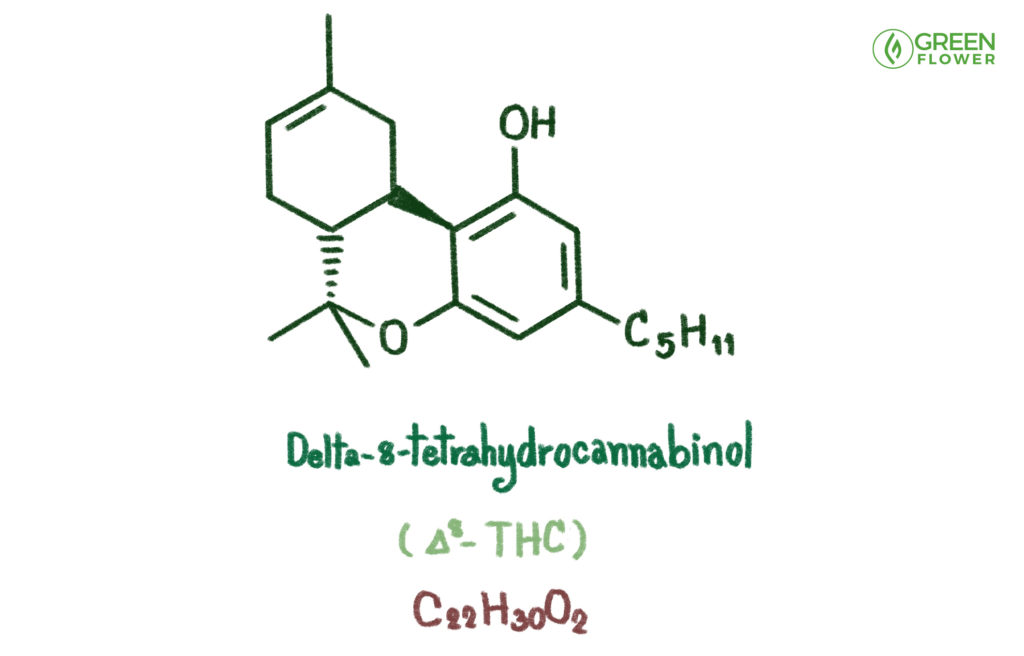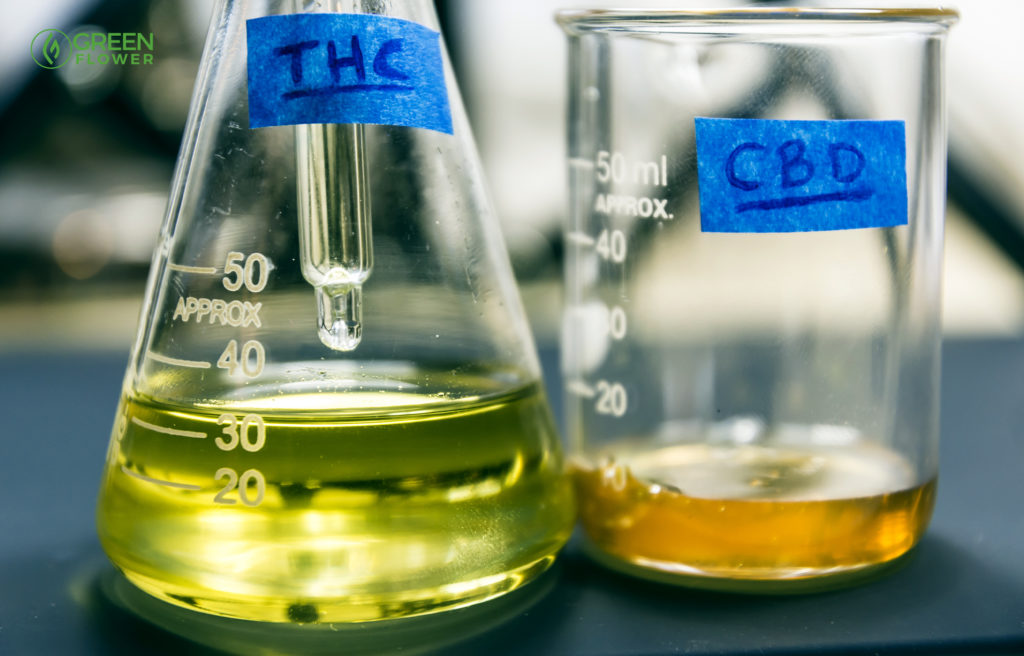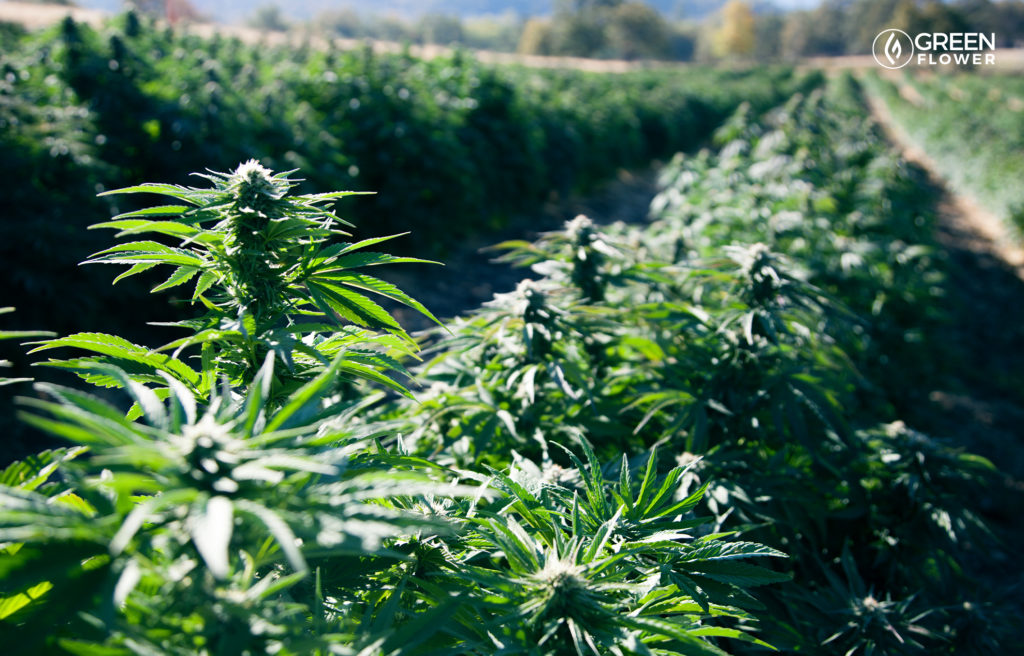With every passing day, it seems that new compounds with unique characteristics and effects are discovered within Cannabis sativa. As researchers and clinicians dive deeper into what is known as the “plant of one thousand and one molecules,” cannabis continues to surprise us in subtle yet significant ways.1 Most recently, delta-8-THC, a curious chemical constituent of the cannabis plant, is making waves in the hemp and cannabis industries due to its favorable clinical profile and uncertain legal status. This guide is meant to serve as an evidence-based exploration examining the sudden arrival of this fascinating THC analogue and its industry implications from a clinical and legal standpoint.

What Exactly Is Delta-8-THC? A Scientific Review
One of at least 30 known THC analogues, delta-8-THC is similar to its psychoactive cousin, delta-9-THC, with some notable exceptions. Molecularly, the most notable difference is that the double bond on the cannabinoid molecule is in the 8 position instead of the 9 position, like in delta-9-THC (hence the name). The close positioning of the double bonds between delta-8-THC and delta-9-THC account for the similarity in their mechanism of action and clinical effects. However, there are some notable differences between the way delta-8-THC presents itself clinically and its better-known counterpart, delta-9. The National Cancer Institute defines delta-8-THC as, “An analogue of tetrahydrocannabinol (THC) with antiemetic, anxiolytic, appetite-stimulating, analgesic, and neuroprotective properties … This agent exhibits a lower psychotropic potency than delta-9-tetrahydrocannabinol (delta-9-THC), the primary form of THC found in cannabis.”2 This reduced psychoactivity of delta-8-THC, combined with some other notable clinical benefits discussed further in this piece, have made this analogue an attractive target for therapeutics research.
Where Does The Delta-8-THC In The Explosion Of New Products Originate?
It should be carefully noted that cannabis does not naturally express appreciable amounts of delta-8-THC, and therefore cannot be economically extracted from marijuana or hemp plants. Instead, current industry practice involves a chemical conversion of CBD (extracted from hemp) that produces both delta-8-THC and delta-9-THC. Further exploration of this process and the origins of the delta-8-THC currently being used in products raises interesting and important legal concerns that warrant further discussion — which will be expanded upon later in the article.

A Brief Overview Of The CBD To THC Conversion Process
Without getting too lost in the details, this guide will briefly summarize the general process of converting CBD to the delta-8 and delta-9 analogues of THC. The process is begun by dissolving CBD in a solution comprising a Lewis acid in an organic solvent (e.g. sulfuric acid in glacial acetic acid), and then mixing said mixture. The cited patent suggests refluxing said mixture under a nitrogen atmosphere, diluting with an organic solvent, and then pouring this mixture into cold water. Afterward, the mixture is allowed to stand at room temperature for an extended period of time so that it can separate into an aqueous phase and organic phase.3 To give the reader an idea, current estimates by reputable industry sources estimate that after three hours, CBD has been converted into 52% delta-9-THC and 2% delta-8-THC (the example uses sulfuric acid in glacial acetic acid). Further, “After 3 days, a mixture of 15% delta-9-THC, 54% delta-8-THC, 10% delta-8-iso-THC and 10% CBD has formed.”4 At this point, there will be a clear separation of the organic and aqueous phases of the solution which will require further separation, since the compounds of interest are in the organic phase. Eluting (a fancy word for “carefully separating”) the delta-8-THC from the organic phase is the final step in this general procedure. This novel process is being fine-tuned and optimized by industry professionals for the time being, given that the legal status of delta-8-THC remains in uncertain limbo.
A Scientific Review Of Delta-8-THC’s Clinically Therapeutic Benefits In Pediatric Oncology
While the aforementioned chemical conversion process is certainly interesting, perhaps even more intriguing are the clinical benefits exhibited by this cannabinoid analogue. A most remarkable example is the use of delta-8-THC in children with cancer who were receiving chemotherapy. “In a study of eight children, ages three to 13, delta-8-THC was found to completely block their chemotherapy-induced vomiting.”5 Furthermore, delta-8-THC seems to induce markedly less anxiety compared to its cousin, delta-9-THC, even when used in higher doses (at least in rats).6 Indeed, the children in the cancer study tolerated delta-8-THC fairly well and with no significant side effects. These clinical findings, while early and limited, certainly seem to suggest a promising future in therapeutics for delta-8-THC. A closer look at the more abundant, pre-clinical animal trials suggests that delta-8-THC could have a promising future due to its medical value.
Animal Studies Investigating Delta-8-THC Suggest A Promising Future For The Compound
While the explosion of delta-8-THC products may be taking the world by storm, animal studies into the compound have been ongoing for decades. In the world of animal studies (mice, to be specific), one interesting study, conducted in 1975 by the National Cancer Institute, sparked curiosity into this molecule. The study, initially meant to uncover harmful effects of delta-8-THC on the immune system, ended up finding that cancer growth was stunted and that “mice treated for 20 consecutive days with Δ8-THC and CBN had reduced primary tumor size.”7 This prompted further studies which explored the science behind delta-8-THC, with one of the first, following the aforementioned National Cancer Institute research, studying metabolic disposition of delta-8-THC and its active metabolites in mice.8 Thus, the modern resurgence in society of delta-8-THC, through this unique conversion process, is the byproduct of early research with rodents that began decades ago. Finally, unlike delta-9-THC, studies in the late ’90s demonstrated that delta-8-THC has activity at both the CB1 and CB2 cannabinoid receptors.9 As researchers take these findings and expand upon them in more comprehensive pre-clinical and clinical trials into the future, it will certainly be interesting to see what is yet to be uncovered about this compound.
Guild Extracts & The Clear Scientist Debut Delta-8-THC, Launch Its Modern Revival
Guild Extracts is generally recognized as the first company to make products with delta-8-THC c and introduce them into the market.10 It is likely that they garnered knowledge about the process from the previously cited U.S. patent that outlines the conversion process. They describe delta-8-THC as a valuable cannabinoid that is rare due to its “spontaneous” and limited presence in that cannabis plant. While the current methodology of converting CBD to both delta-8 and delta-9-THC is certainly innovative, it also raises some novel challenges, as can be seen when examining the questions of legality that it raises.

Legal Implications Of Delta-8-THC In The Modern Hemp Industry
Since cannabis plants don’t naturally produce delta-8-THC in significant enough quantities to warrant extraction, the industry has turned to using the aforementioned chemical process. But how does this fare with the current legal status of CBD and THC? The fact of the matter is that taking hemp and extracting CBD from said hemp is undoubtedly lawful. However, things become hazy from a legal perspective when this CBD is chemically converted to delta-8-THC and sold in a world where a very close analogue of this compound, delta-9-THC, is still very much federally controlled, being recognized as an illegal Schedule I substance. The thing is, all the other cannabinoids, (other than delta-9-THC), when expressed in quantities greater than 0.3%, are not controlled substances or outlawed. So where exactly does delta-8-THC, extracted from legal, hemp-derived CBD, fit into the current regulatory framework? A closer look at the law indicates that the cannabinoid CBD, and all hemp-derived cannabinoids, are actually themselves considered “hemp” under the current statute. By this language, it stands to reason that since CBD derived from hemp is considered “hemp” itself, then delta-8-THC derived from this hemp-derived CBD is also a legal substance. However, this is purely speculation gathered from expert lawyers in the industry, such as Rod Kight, who discussed these legal topics in a recent episode of the CBD Business Accelerator podcast. Currently, the DEA could test this theory by either acknowledging the statute and outright disagreeing with it, or by misinterpreting the statute. Such issues are certainly concerning in this industry; however, due to its therapeutic value, delta-8-THC is likely to stick around.
Economic Considerations For The Hemp & Cannabis Industries With Respect To Delta-8-THC
The recent emergence of delta-8-THC in both the medical and recreational markets, as well as in some notable research studies, have created a peculiar, steadily rising demand for this cannabinoid analogue. The efficacy, reduced psychoactivity, and chemical stability of this cannabinoid have begun to establish a place for delta-8-THC within society and the modern medical cannabis community. From an investment standpoint, this compound holds significant potential in the area of cannabinoid therapeutics and drug design. With respect to hemp farmers and current industry trends, it is possible — since the demand for THC outweighs that of CBD — that farmers can take advantage of this unique opportunity to value their product (e.g. hemp biomass, hemp flower, CBD oil) higher. Overall, this unique cannabinoid analogue is certainly making waves in the clinical and legal landscape within the cannabis and hemp spaces, and should be followed closely by anyone with a stake in the market.
Works Cited
- Cannabis sativa: The Plant of the Thousand and One Molecules. https://www.ncbi.nlm.nih.gov/pmc/articles/PMC4740396/.
- NCI Drug Dictionary. National Cancer Institute https://www.cancer.gov/publications/dictionaries/cancer-drug (2011).
- US20040143126A1 – Conversion of cbd to delta8-thc and delta9-thc – Google Patents. https://patents.google.com/patent/US20040143126A1/en.
- Isomerization to Delta 8 THC. Future4200 https://future4200.com/t/isomerization-to-delta-8-thc/1222 (2018).
- An efficient new cannabinoid antiemetic in pediatric oncology – ScienceDirect. https://www.sciencedirect.com/science/article/abs/pii/002432059500194B.
- Wirguin, I. et al. Suppression of experimental autoimmune encephalomyelitis by cannabinoids. Immunopharmacology 28, 209–214 (1994).
- Munson, A. E., Harris, L. S., Friedman, M. A., Dewey, W. L. & Carchman, R. A. Antineoplastic activity of cannabinoids. J. Natl. Cancer Inst. 55, 597–602 (1975).
- Watanabe, K., Yamamoto, I., Oguri, K. & Yoshimura, H. Metabolic disposition of delta 8-tetrahydrocannabinol and its active metabolites, 11-hydroxy-delta 8-tetrahydrocannabinol and 11-oxo-delta 8-tetrahydrocannabinol, in mice. Drug Metab. Dispos. Biol. Fate Chem. 9, 261–264 (1981).
- Pertwee, R. G. The diverse CB1 and CB2 receptor pharmacology of three plant cannabinoids: Δ9-tetrahydrocannabinol, cannabidiol and Δ9-tetrahydrocannabivarin. Br. J. Pharmacol. 153, 199–215 (2008).
- Delta 8. Guild Extracts http://www.guildextracts.com/delta-8.

